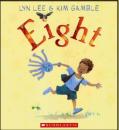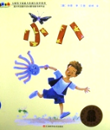AustLit
Latest Issues
AbstractHistoryArchive Description
'Eight is a plush toy octopus. He and Timmy have been together for a long time, and he is a special toy, the one that goes to bed with Timmy and sometimes even to school with him, too. They are almost inseparable. One day, Timmy and Mum and Dad go for a picnic in the national park, and Eight comes too. They go for a walk in the bush and a row on the river and play near the water.
'Suddenly it starts to rain, and Mum and Dad and Timmy gather all the picnic things together quickly and pack up and go home. It’s raining heavily now, but Timmy has a hot bath and something to eat and goes to bed. As the storm goes on outside, Timmy wakes in horror to find that Eight is not in bed with him. He must still be at the picnic spot in the national park! Timmy and his parents go to look for Eight the next day, but he is nowhere to be found. Timmy is sad to lose his friend, and wonders about what he is doing. Dad suggests that maybe Eight woke early, and made a raft and sailed down the river. What would he do if he met pirates, Timmy wonders.
'While Timmy returns to life without Eight, his toy has many adventures, which may be just in Timmy’s imagination, or not ... One day Timmy and Dad are down by the water again, and Timmy is looking in the shallows, finding interesting things. At first he finds a bucket which looks a little like one he has played with once before, and which Eight might even have used for a pirate’s hat. He sees something stuck in a mangrove and pulls out a very sodden Eight! They take him home for a spin in the washing machine and the clothes drier, and Eight is as good as new.
'Timmy feels now that his friend can sit on his shelf where the boy can see him, as Eight is big and strong enough and brave enough to sleep on his own.' (Publication summary)
Notes
-
This is affiliated with Dr Laurel Cohn's Picture Book Diet because it contains representations of food and/or food practices.
Food depiction - Incidental
Food types - Everyday foods
- Discretionary foods
- High sugar foods
- High fat foods
Food practices - Eating out - picnics
- Food serving
Gender - Food serving - female
Signage n/a Positive/negative value n/a Food as sense of place n/a Setting - bush/beach/nature
Food as social cohesion - Family meals [picnic lunch]
Food as cultural identity - White Australian characters
Food as character identity n/a Food as language n/a
Publication Details of Only Known VersionEarliest 2 Known Versions of
Other Formats
- Sound recording.
- Braille.
Works about this Work
-
What Are We Feeding Our Children When We Read Them a Book? Depictions of Mothers and Food in Contemporary Australian Picture Books
2016
single work
criticism
— Appears in: Mothers and Food : Negotiating Foodways from Maternal Perspectives 2016; (p. 232-244)'This chapter explores how Australian writers and illustrators in the twenty-first century depict the act of mothering in picture books for young children in relation to cooking and serving food. It draws on the idea that children’s texts can be understood as sites of cultural production and reproduction, with social conventions and ideologies embedded in their narrative representations. The analysis is based on a survey of 124 books that were shortlisted for, or won, Children’s Book Council of Australia awards between 2001 and 2013. Of the eighty-seven titles that contain food and have human or anthropomorphised characters, twenty-six (30 percent) contain textual or illustrative references to maternal figures involved in food preparation or provision. Examination of this data set reveals that there is a strong correlation between non-Anglo-Australian maternal figures and home-cooked meals, and a clear link between Anglo-Australian mothers and sugar-rich snacks. The relative paucity of depictions of ethnically unmarked mothers offering more nutritious foods is notable given the cultural expectations of mothers as caretakers of their children’s well-being. At the same time, the linking of non-Anglo-Australian mothers with home-cooked meals can be seen as a means of signifying a cultural authenticity, a closeness to the earth that is differentiated from the normalised Australian culture represented in picture books. This suggests an unintended alignment of mothers preparing and serving meals with “otherness,” which creates a distancing effect between meals that may generally be considered nutritious and the normalised self. I contend there are unexamined, and perhaps unexpected, cultural assumptions about ethnicity, motherhood, and food embedded in contemporary Australian picture books. These have the potential to inscribe a system of beliefs about gender, cultural identity, and food that contributes to readers’ understanding of the world and themselves.'
Source: Abstract.
-
The Children's Book Council of Australia Judges' Report 2007
2007
single work
column
— Appears in: Reading Time : The Journal of the Children's Book Council of Australia , August vol. 51 no. 3 2007; (p. 5-12) -
Untitled
2006
single work
review
— Appears in: Reading Time : The Journal of The Children's Book Council of Australia , November vol. 50 no. 4 2006; (p. 43)
— Review of Eight 2006 single work picture book -
Untitled
2006
single work
review
— Appears in: Magpies : Talking About Books for Children , September vol. 21 no. 4 2006; (p. 28)
— Review of Eight 2006 single work picture book -
Celebrating the Ordinary
2006
single work
review
— Appears in: Australian Book Review , November no. 286 2006; (p. 57-59)
— Review of Waltzing Matilda 2006 single work picture book ; The Thirsty Flowers 2006 single work picture book ; Nog the Nag Bird 2006 single work picture book ; Ella Kazoo Will Not Brush Her Hair 2006 single work picture book ; Eight 2006 single work picture book ; A Particular Cow 2006 single work picture book ; Chatterbox 2006 single work picture book ; Midsummer Knight 2006 single work picture book ; Uno's Garden 2006 single work picture book ; Water Witcher 2006 single work picture book ; Grandpa and Thomas and the Green Umbrella 2006 single work picture book ; Kestrel 2006 single work picture book ; Bobbie Dazzler 2006 single work picture book ; Bushranger Bill 2006 single work picture book ; Moon Bear Rescue 2006 single work picture book ; The Friends of Apple Street 2006 single work picture book ; The Music Tree 2006 single work picture book ; It's Christmas 2006 single work picture book ; Pemberthy Bear 2006 single work picture book ; Samsara Dog 2006 single work children's fiction ; Norman and Brenda 2006 single work picture book
-
This Week's Selections
2006
single work
review
— Appears in: The Advertiser , 21 October 2006; (p. 10)
— Review of Eight 2006 single work picture book -
Castor-Oil Goodness
2006
single work
review
— Appears in: The Sydney Morning Herald , 28-29 October 2006; (p. 37)
— Review of Norman and Brenda 2006 single work picture book ; Samsara Dog 2006 single work children's fiction ; Eight 2006 single work picture book ; Midsummer Knight 2006 single work picture book -
Celebrating the Ordinary
2006
single work
review
— Appears in: Australian Book Review , November no. 286 2006; (p. 57-59)
— Review of Waltzing Matilda 2006 single work picture book ; The Thirsty Flowers 2006 single work picture book ; Nog the Nag Bird 2006 single work picture book ; Ella Kazoo Will Not Brush Her Hair 2006 single work picture book ; Eight 2006 single work picture book ; A Particular Cow 2006 single work picture book ; Chatterbox 2006 single work picture book ; Midsummer Knight 2006 single work picture book ; Uno's Garden 2006 single work picture book ; Water Witcher 2006 single work picture book ; Grandpa and Thomas and the Green Umbrella 2006 single work picture book ; Kestrel 2006 single work picture book ; Bobbie Dazzler 2006 single work picture book ; Bushranger Bill 2006 single work picture book ; Moon Bear Rescue 2006 single work picture book ; The Friends of Apple Street 2006 single work picture book ; The Music Tree 2006 single work picture book ; It's Christmas 2006 single work picture book ; Pemberthy Bear 2006 single work picture book ; Samsara Dog 2006 single work children's fiction ; Norman and Brenda 2006 single work picture book -
Untitled
2006
single work
review
— Appears in: Magpies : Talking About Books for Children , September vol. 21 no. 4 2006; (p. 28)
— Review of Eight 2006 single work picture book -
Untitled
2006
single work
review
— Appears in: Reading Time : The Journal of The Children's Book Council of Australia , November vol. 50 no. 4 2006; (p. 43)
— Review of Eight 2006 single work picture book -
The Children's Book Council of Australia Judges' Report 2007
2007
single work
column
— Appears in: Reading Time : The Journal of the Children's Book Council of Australia , August vol. 51 no. 3 2007; (p. 5-12) -
What Are We Feeding Our Children When We Read Them a Book? Depictions of Mothers and Food in Contemporary Australian Picture Books
2016
single work
criticism
— Appears in: Mothers and Food : Negotiating Foodways from Maternal Perspectives 2016; (p. 232-244)'This chapter explores how Australian writers and illustrators in the twenty-first century depict the act of mothering in picture books for young children in relation to cooking and serving food. It draws on the idea that children’s texts can be understood as sites of cultural production and reproduction, with social conventions and ideologies embedded in their narrative representations. The analysis is based on a survey of 124 books that were shortlisted for, or won, Children’s Book Council of Australia awards between 2001 and 2013. Of the eighty-seven titles that contain food and have human or anthropomorphised characters, twenty-six (30 percent) contain textual or illustrative references to maternal figures involved in food preparation or provision. Examination of this data set reveals that there is a strong correlation between non-Anglo-Australian maternal figures and home-cooked meals, and a clear link between Anglo-Australian mothers and sugar-rich snacks. The relative paucity of depictions of ethnically unmarked mothers offering more nutritious foods is notable given the cultural expectations of mothers as caretakers of their children’s well-being. At the same time, the linking of non-Anglo-Australian mothers with home-cooked meals can be seen as a means of signifying a cultural authenticity, a closeness to the earth that is differentiated from the normalised Australian culture represented in picture books. This suggests an unintended alignment of mothers preparing and serving meals with “otherness,” which creates a distancing effect between meals that may generally be considered nutritious and the normalised self. I contend there are unexamined, and perhaps unexpected, cultural assumptions about ethnicity, motherhood, and food embedded in contemporary Australian picture books. These have the potential to inscribe a system of beliefs about gender, cultural identity, and food that contributes to readers’ understanding of the world and themselves.'
Source: Abstract.






